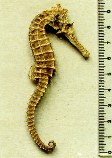| Family: |
Syngnathidae (Pipefishes and seahorses), subfamily: Syngnathinae |
| Max. size: |
22 cm TL (male/unsexed) |
| Environment: |
reef-associated; marine; depth range 3 - 63 m, non-migratory |
| Distribution: |
Indo-West Pacific: Australia (Western Australia to Queensland). |
| Diagnosis: |
Dorsal spines (total): 0-0; Dorsal soft rays (total): 17-19. Description: (based on 54 specimens): Adult height: 7.8-15.5 cm. Rings: 11 + 33-34 (32-35). Snout length: 2.2 (2.0-2.5) in head length. Dorsal fin rays: 18 (17-19) covering 2+1 rings. Pectoral fin rays: 16-17 (15-19). Coronet: medium height with 5 well developed sharp spines. Spines: well developed (blunt or sharp tips); usually low in neck region. Other distinctive characters: double sharp cheek spines; double spine below eye; prominent, sharp eye spine. Color pattern: body often covered in a net-like pattern of brown markings; snout with fine stripes; spines with a brown band towards their tip. |
| Biology: |
Found in sheltered bays. Color varies from either white, orange or yellow with light patches and sometimes network of fine dark lines; also with narrow lines across snout. Ovoviviparous (Ref. 205), monogamous (Ref. 36642). The male carries the eggs in a brood pouch which is found under the tail (Ref. 205). |
| IUCN Red List Status: |
Least Concern (LC); Date assessed: 19 August 2016 Ref. (130435)
|
| Threat to humans: |
harmless |
Source and more info: www.fishbase.org. For personal, classroom, and other internal use only. Not for publication.

